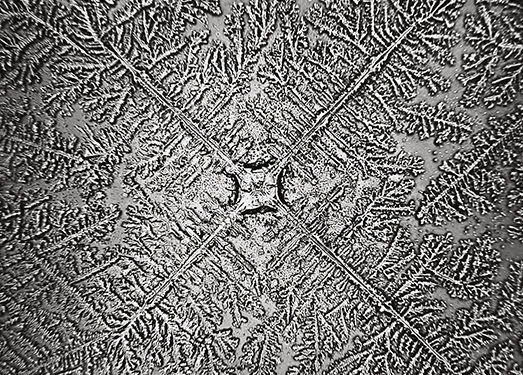Identifying the spectrum of human emotion in the beauty of tears
“We do not know the worth of one single drop of blood, one single tear.” — Fran√ßois Mauriac, Catholic novelist
LA photographer Rose-Lynn Fisher has made a study of tears in her new book, “The Topography of Tears” (Bellevue Literary Press, $20). By gazing through an optical microscope and capturing images that are magnified 100 times, she reveals part of what she calls the “emotional terrain” of the human condition.
The sheer strangeness, variety and beauty of her “photomicrographs” are stunning. What also fascinates is to discover that the topography isn’t entirely foreign. Whether the tears are of sadness or joy, regret or elation, to pore over them is to enter a half-remembered kingdom, a dreamscape.
Fisher was born in Minnesota. “I grew up with snowfall. We lived near a pond. We’d hunt agates and feed ducks in summer and ice skate in winter,” she said.
Her family moved to LA when she was 8. “But certain patterns and geometries impress themselves upon us as children and mark us. The magic of a snowflake and the urge to contemplate the shapes of things have stayed with me.”
The project was inspired by the death of an old friend, a man who, when Fisher had fallen ill while traveling in Italy many years before, had nursed her with great care.
“The day I received word of Patrick’s death I was just crying and crying and crying,” she said. “But at some point, I also had an ‘aha!’ moment. What are these tears actually? Do all tears look the same? I had just acquired a microscope and was learning how to use it. I didn’t really know what to look at. That’s when I realized — Oh! I could look at these tears!”
Fisher began to keep glass slides around the house and in her purse. She saved some tears by simply letting them air-dry. Others she compressed between a slide and a cover slip, which led to a spreading out of the liquid.
“In the book, I tried to create a flow, an order going from those that look more pictorial and compressed to those that look more organically patterned and are air-dried,” she said.
“Take ‘Compassion,’ for example, a photo of a tear that was air-dried. It’s so lyrical. It’s wonderful to have experienced the empathy that provoked that tear and then to see it under the microscope so full of movement and harmony. I look at the image and begin to see the bigger story of compassion.”
Fisher consulted scientists. The exact chemical composition of any given emotional tear, they reported, is impossible to categorize or predict. (Onion tears, which are reflexive tears, have less protein than emotional tears).
To do a thorough scientific study would require not just one person saving a hundred tears, but a hundred people saving a hundred tears. Each tear would then have to be saved under the same emotional conditions, the same environmental conditions and processed the same way.
“Also, emotions can combine more than one feeling,” she explained. “You can feel grief and appreciation simultaneously, for example, or rage and fear. At the moment, there’s no way to quantifiably separate what those emotions are and what causes them.”
The skeptic will say that you can read into each photo whatever you want. The mystic will note that the central shape of “What Can’t Be Fixed” resembles a fractured heart, that the forms in “After Goodbye” evoke scars and that “Redemption” is centered on what is clearly a cross.
“Each tear is like one drop in the ocean that connects all of us,” she said. “That the shapes are so different is striking! Onion tears are reflexive, not emotional. But there are visual differences between each person’s tears, and even among the same emotional tears of the same person, depending on the volume of the tear and other factors.”
Each tear in the book also has a story behind it — but actually to tell it was never Fisher’s aim. Instead, she composed pithy, evocative titles that are like small poems: “Old mistakes under a new sky”; “Momentum, redirected”; “Saturated and depleted”; “Abounding, abiding”; “Godspeed, sweet light of my heart.”
“I didn’t want to create the impression that some tears are more ‘important’ than others. I wanted to express something of what generated the tear but also to invite the viewer to find his or her own story within it,” she said.
If the project was generated in part by grief, the photos also manage to convey a beautifully wide spectrum of human emotion. Perhaps that’s why “The Topography of Tears” is paradoxically a book of so much of hope and beauty. Juxtaposed with a sense of loss is also a sense of transition, resiliency and resurrection.
“The images show the poetry of life. They give back information, but the information is intangible, in the sense of something you can’t touch, that’s more spiritual, that you respond to on some level that’s not rational,” she said. “The response to the photos isn’t through mind or idea or thought. The image is somehow rather the bridge back to the emotion, the feeling. That to me is the most interesting part of the process of doing this project.
“It’s like looking through a rearview mirror at the reflection of a placeless place. Somewhere that you were once that doesn’t really exist. But there’s a picture of it now.”
 rn
rn
rn
Additional images from “The Topography of Tears” can be viewed by visiting www.rose-lynnfisher.com.
Heather King is a blogger, speaker and the author of several books.
Interested in more? Subscribe to Angelus News to get daily articles sent to your inbox.

